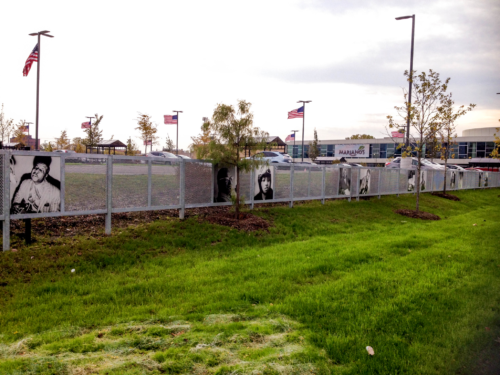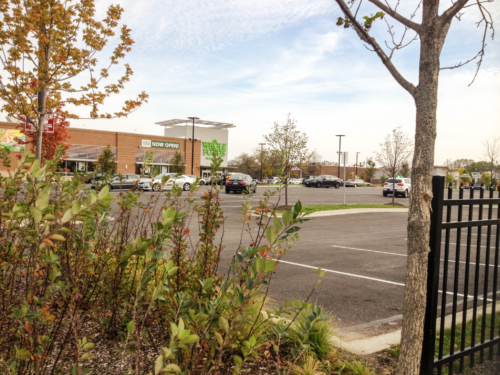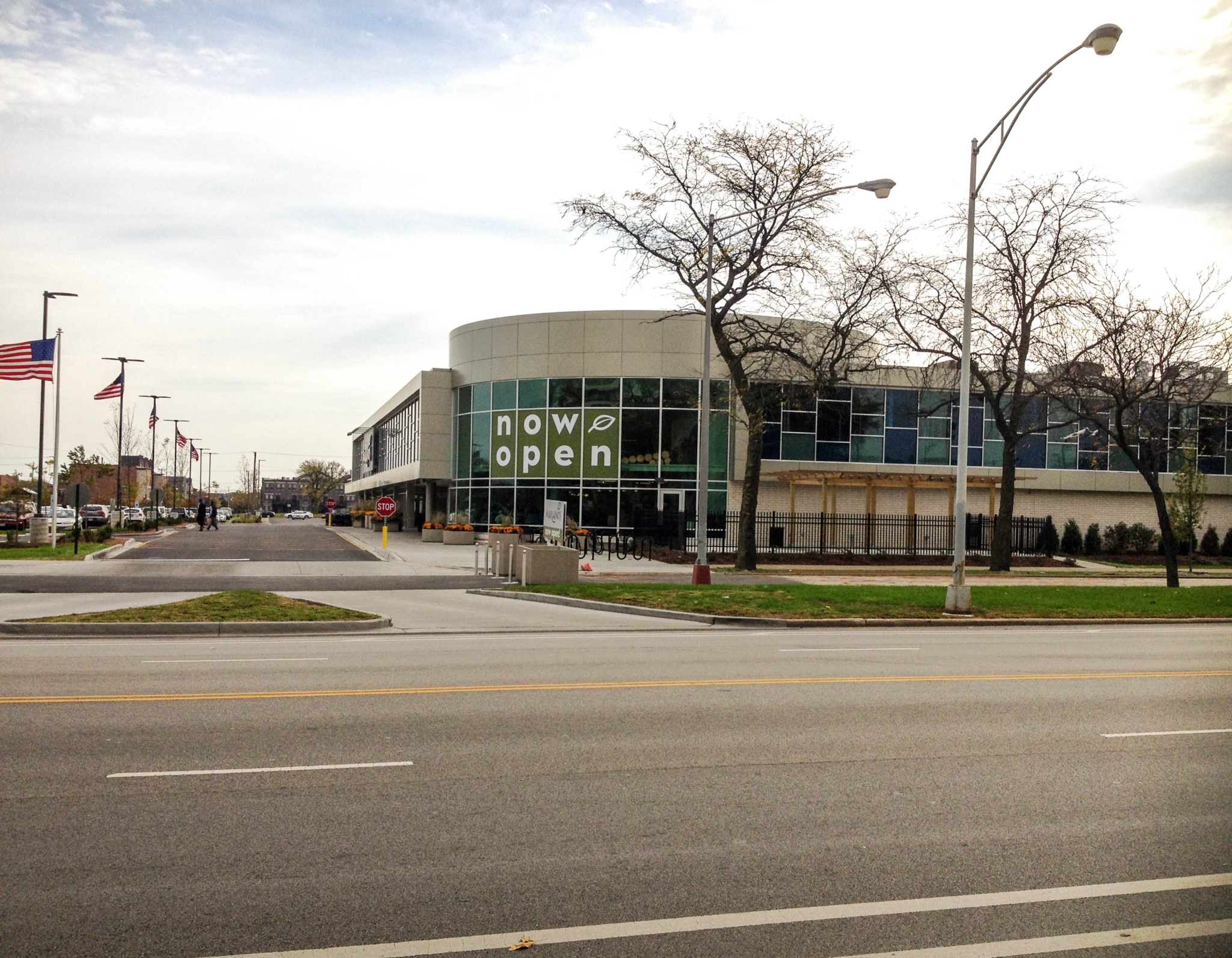Abuilding’s design tells you a lot about who it’s for. The new faux-Parisian townhomes in Lincoln Park appeal to people who want to imitate the prestige and sophistication of a European capital. The large, bright windows of a traditional commercial storefront ask everyone in the neighborhood to come in and check out the merchandise.
Little media coverage so far has been given to the urban design of two high-profile grocery stores that opened in South Side neighborhoods this fall: a Whole Foods in Englewood and a Mariano’s in Bronzeville. In part, that’s understandable: new full-service chain groceries don’t open in black neighborhoods in Chicago very often, and both of these openings dramatically increase the quality of food options for their communities, while creating hundreds of jobs—the design, at first, wouldn’t seem to be the most important thing. But now that the dust has settled, it’s worth taking a minute to think about what these buildings look like, and what their designs tell us about who they’re for.
The Englewood Whole Foods sits at the corner of 63rd and Halsted Streets, once one of the most bustling neighborhood downtowns in the city. Though it has been decimated by years of neglect, there’s still a Green Line station a block south and the campus of Kennedy-King College across the street, as well as several remaining businesses and the intersection of two major bus lines. Together, these factors keep a steady stream of pedestrians at the corner much of the time.
Whole Foods might have chosen to embrace this corner, helping contribute to the revitalization of an entire district by placing itself alongside other storefronts and businesses, and making itself a highly visible community institution to the people passing by Halsted and 63rd as they make their way around their neighborhood. Instead, it chose to be a suburban fortress. While a small, insignificant-looking structure sits on the corner, the main building is hundreds of feet away from the sidewalks at the intersection. In between is a massive parking lot, surrounded by a fence that reinforces the idea that Whole Foods is walled off from Englewood, rather than embracing it.

In some ways, the Bronzeville Mariano’s is even worse. One side of the building faces Pershing Street, a commercial corridor pockmarked with empty lots that would benefit enormously from a big anchor store that brought people and their business to the street. Instead, Mariano’s presents Pershing with a low, windowless blank wall the length of a block, ensuring that the spillover from store to store that urban retail districts rely on will be absent.
The other side of Mariano’s faces King Drive, perhaps the most beautiful street in Bronzeville and an iconic part of the citywide boulevard system. Half of this side is another blank wall; the other half is a parking lot. Most heinously, the city allowed Mariano’s to pave two broad, car-sized driveways into the planted median of the boulevard itself to make it easier for cars coming from either direction to enter the parking lot. Ironically, this year the city nominated our boulevard system for the National Register of Historic Places; unceremoniously paving over part of that system, which dates back to 1869, is a strange way of showing how much you care. Bronzeville residents wouldn’t be wrong to ask whether the city would dare allow cement trucks to back up onto, say, Kedzie Boulevard in Logan Square.
Both of these stores present two big issues. The first is that their buildings take away from, rather than contribute to, the kind of continuous flow of buildings and shops that makes a neighborhood downtown more than just the sum of its parts, and which creates a sense of community and identity, as on 79th Street in Chatham or 26th Street in Little Village. These stores declare themselves not a part of, but apart from, their communities.

The second is more practical: these are buildings that literally turn their backs on the tens of thousands of people who might like to shop there, but don’t drive. In the parts of Englewood surrounding Whole Foods, up to forty percent of households don’t own a car; in the census tract of Bronzeville, where Mariano’s sits, that number is around a third. But both stores’ designs declare that they are for people who drive first, and everyone else last. Their entrances face parking lots, rather than the sidewalk, and while each has taken the minimal step of creating a private walkway from the sidewalk to the door, the reality is that many pedestrians, including children, the elderly, and people with limited mobility, will find that the fastest way to get to the store is by crossing a large space made for cars, a situation that is always inconvenient and often dangerous.
It’s more than possible to avoid this problem while accommodating drivers: in two North Side and one Near West Side location, Mariano’s has shown that it is capable of building stores that meet the street, with entrances and windows on the sidewalk, while also making room for parking behind or above the main building.
But you don’t even need to go that far. At 47th Street and Cottage Grove, a coalition of local nonprofits created space for a Walmart Neighborhood Market grocery store in a building that, while not perfect, placed storefronts with windows and entrances right on the sidewalk, helping rebuild the fabric of two major Bronzeville streets. Even better, they put three stories of affordable housing on top, adding to the density of local customers that neighborhood retail districts need to survive and making a small dent in the city’s deficit of low-cost apartments. Why this wasn’t done at the two newer stores—particularly the Mariano’s, which was built on land bought from the Chicago Housing Authority—is unclear.
These two new grocery options on the South Side are undeniably good news. But we can recognize that good news while also demanding that the companies that redevelop our neighborhoods do so in ways that add to, rather than subtract from, the physical fabric of the surrounding community. These new developments should also cater to all potential customers equally, regardless of how they arrive at the store. Chicagoans deserve that much.
Daniel Kay Hertz writes about Chicago and urban policy. In addition to South Side Weekly, he has been published at the Chicago Reader, Chicago Magazine, The Atlantic and the Washington Post. He currently works for the Center for Tax and Budget Accountability, though all the opinions in this piece are his alone.


While reading, I kept thinking how excellent this article is. I did not realize it was contributed by Hertz. Keep up the amazing work
Mr. Hertz,
As one who was born in Bronzeville and returned as an adult homeowner, I think you are a bit mistaken about issues of access to Marianos Grocery Store. Access via King Drive is certainly preferable to Pershing Road in terms of convenience. And pedestrians do not have to cross the parking lot to get to the store entry, the walkway to the door from King Dr. is a relatively short one. I say this as one who has written my share of critical letters to store execs who have placed their entries at what seemed like “blocks” from any sidewalk. In addition, since you noticed that Mariano’s is on an historic boulevard, it would be impossible to design storefront access of the type employed at 47th and Cottage and still even try to fit in with the desired streetscape. As a long term resident, the design of any commercial development proposed for the boulevard, was problematic. There are always tradeoffs. Create “storefronts” and hope to encourage more foot traffic or put the entrance along the more traveled thorofare used by both cars and busses for decades.
Actually, the more important factor here was, and still is, where is the affordable housing for the residents displaced by the demolition of the Ida B. Wells homes?
How true, and very well said.
Spot on analysis. The suburbanization of the city continues unabated. New retail in Chicago mimics the suburban strip mall setting buildings back from the sidewalk and placing a parking lot between the two. If this keeps up Chicago will lose all urban character and replace it with soulless, nondescript boxes set in a sea of asphalt.
Actually no, DKH. It’s funny how yous showed no photos of the back wall, which is embellished with six 10′ wide x 13′ tall images drawn from Bronzeville’s Renaissance period of 1935 – 55. The fence along King Drive, between 38th and 39th with images of 26 of Bronzeville’s most notable residents. No other store of any type in the US so honors the community it serves. The Marianos ended Bronzeville’s status as a food desert and has brought hundreds of much-needed jobs to the community.
I agree with Daniel that these store should be more resident friendly. As a person who once lived in Chicago and used public transportation to get to and from stores, I can see the drawbacks to having entrances accessible only from the parking lots. Also, if one has heavy bags to carry, it is even worse to have to cross a parking lot to get to a bus stop or train station.